Identifying Fossils by Shape
Identifying Fossils by Shape
The shape of fossils may be used as a general guide in identification.
modified for Australian conditions based on a formatfrom the Geological Survey of Kentucky https://www.uky.edu/KGS/fossils/fossilid.php
line sketches with permission and courtesy of the Kentucky Geological Survey
OK so you have found a fossil and you haven't any idea what it is!
The following may be a helpful guide to at least get you started
Fossils in the field are generally poorly preserved, broken, or partially covered in the matrix of the surrounding rock so that their true size and shape is hidden.
Most commonly found fossils can usually be classified to their group by observing some simple shapes and features.
If your fossil has one of the shapes below, look down the guide for that shape and you will be presented with some possibilities of it's origins.
(Note: mobile phone users may need to view the fossil shape image map in landscape)
Click on the group of shapes on the image map below to get started... or scroll down to the desired shape

There are many shapes and fossils not shown on this diagram, but most of the common shapes are shown.
Circle

Small circular fossils (less than a few centimeters in diameter)
- Crinoid columnals
are generally small circular fossils, a centimeter or less in width.
They may have a hole toward the axis (bead shape) but are common
without holes as well. Common in limestones and shales.
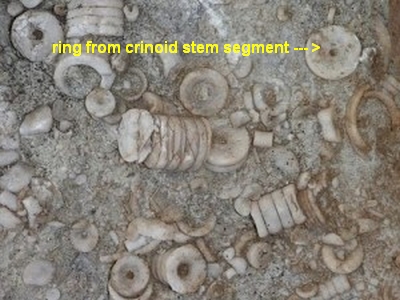
- Cross sectional views or views looking down on the tops or cups of horn
corals can have a circular appearance. Most corals will have
grooves or lines radiating out from the axis. They are generally less
than 3 or 4 centimeters in width.

- Cross sectional views through some types of
bryozoans are circular. Such sections are generally less
than a centimeter in width and are common in Ordovician limestones.

- Atrypa brachiopods , Orbiculoidia brachiopods and some
Productid brachiopods have circular shapes at certain orientations and
do not have grooved ornamentation like many other shelled fossils.
Look to see if you can see a tiny protrusion on one side of the shell
that might be a hinge to the shell valves.

- Cross sectional views fossil plants such as ferns and the
surface of fern trunks such as Lepidodendron

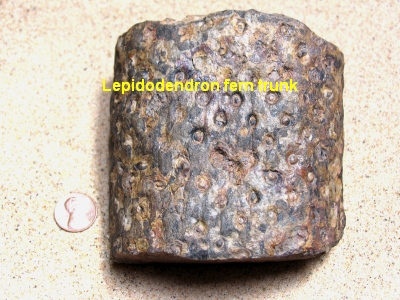
- trace fossils such as worm burrows

Larger circular fossils
- Some horn corals and tabulate corals are circular in
cross section or when looking down from the top. Tabulate coral mounds
may have diameters from centimeters to more than a meter across.

- fossil tree trunks
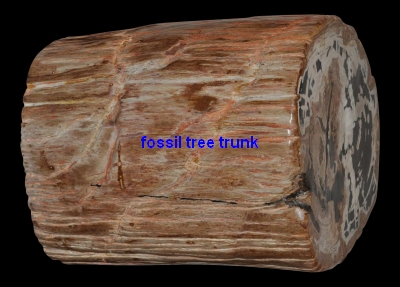
- backbones - individual backbones of mammals, reptiles,
dinosaurs, fish, amphibians have a near circular cross-section
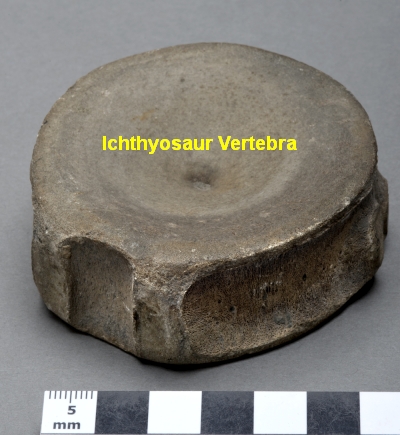
Learn more about our discovery of an Ichthyosaur skeleton
Circle with a hole (bead)

- This shape is common for crinoid columnals. These are generally less than a centimeter across.
Circle with Radiating Lines or Grooves

- Cross sectional views or views looking down on the tops or cups of horn corals can have a circular appearance. Most corals will have grooves or lines radiating out from the axis. They are generally less than 3 or 4 centimeters in width.
- Cross sectional views through some types of bryozoans are circular. Such sections are generally less than a centimeter in width and are common in Ordovician limestones. Bryozoans have a different appearance in section from corals.
- Some crinoid columnals will also have radiating lines outward
from center. Most will also have a hole or depression in the center,
and will be small, generally less than a centimeter in diameter. They
will be bead-like if separated from the rock they are found in.
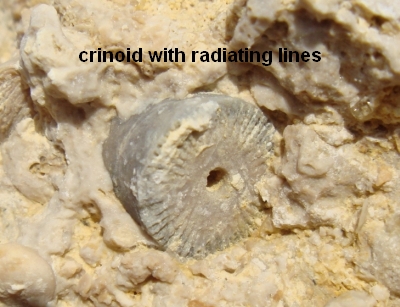
In contrast, bryozoans with circular cross sections will be tubular, and horn corals will often be conical or cup-shaped.
- Cordaite plant fossils
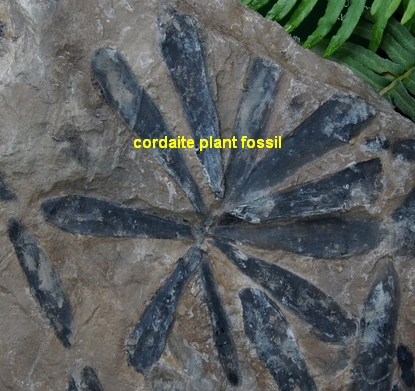
- Some crinoid columnals will also have radiating lines outward from center. Most will also have a hole or depression in the center, and will be small, generally less than a centimeter in diameter. They will be bead-like if separated from the rock they are found in. In contrast, bryozoans with circular cross sections will be tubular, and horn corals will often be conical or cup-shaped.
Circle with hole and radiating lines
- This shape is typical of some crinoid columnals. These are generally less than a centimeter across.
Bead with hole and radiating lines
- This shape is typical of some crinoid columnals. These are generally less than a centimeter across.
Circle with star axis

- This is a crinoid columnal. These are generally less than a centimeter across.
Bead with star axis
- This is a crinoid columnal. These are generally less than a centimeter across.
Egg shapes

Fossil eggs worldwide are very rare. In almost all cases an egg-shaped fossil is something else.
- Most fossil "eggs" are weathered and rounded rocks, rather than
fossils. siderite nodules and concretions can have
smooth, oval shapes and may appear like eggs. Other rocks may be
rounded in streams into oval shapes.
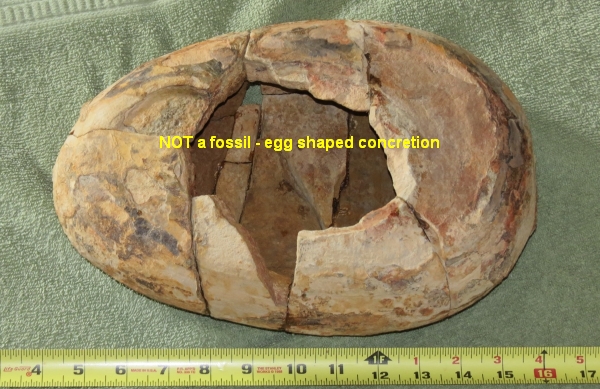
- Some
brachiopods have oval shapes, but are generally small. If
weathered or partially covered in rock, it may be difficult to see
shell ornamentation typical of most brachiopods.

Nut shapes (flower-bulb shaped, bulbous)

- Many nut-shaped fossils are fossil echinoderms called blastoids.
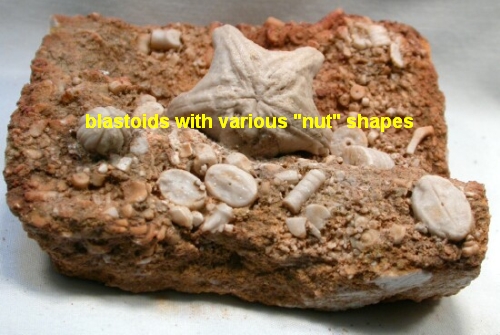
- Some brachiopods,
including the productids have an acorn-like shape.

- True fossil nuts are a rare type of plant fossil
Pentagonal shapes (five-sided)

Pentagonal symmetry is common to echinoderms.
- Top view of a crinoid calyx.
- Fragmentary plates of crinoids, blastoids, and other echinoderms.
5-pointed star shapes
Stars are generally five-sided in fossils, and this type of symmetry is common to echinoderms. Several types of fossil echinoderms can be found in Kentucky.
- Top view of a blastoid calyx, often has a star-shape on it. It can look like a starfish on a blastoid.
- A star-shaped hole in the center of a circular fossil is typical of
some crinoid columnals
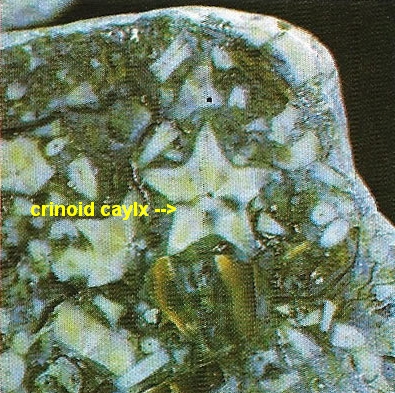
- True starfish fossils are rare but can be found in
limestones and in western Queensland in sandstones.
- Some fossil plants may have narrow leaves around a central stem, causing a star-like shape. There will generally be black (carbon) in gray shale, and from the coal fields.
NOTE: hexagonal shapes are more likely found to be fossilised mudcracks or basalt lava cooling columns
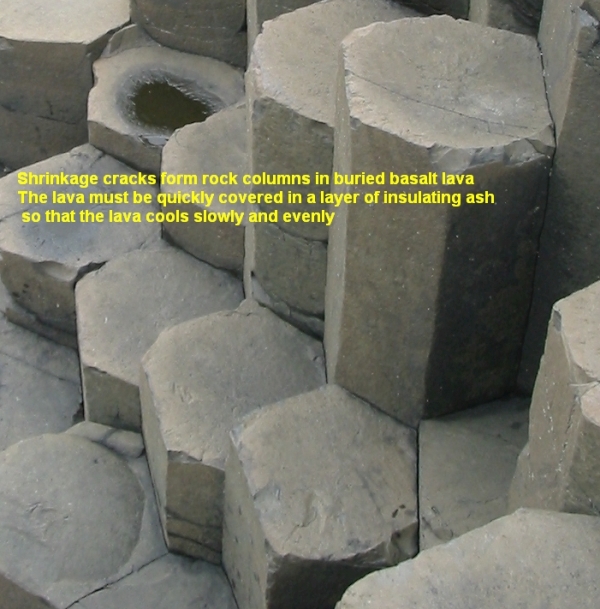
C shapes

Cross sectional views through the valves of shelled animals such as brachiopods and bivalves are most common.
- If two valves are preserved, and the valves are the same (mirror
images) the fossil may be a bivalve (clam).
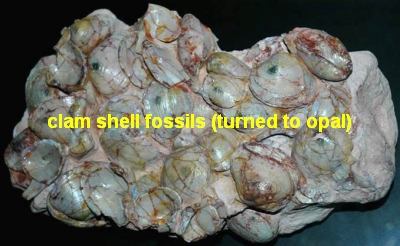
- If two valves are preserved, and the valves are slightly different
in shape, the fossil is probably a brachiopod.
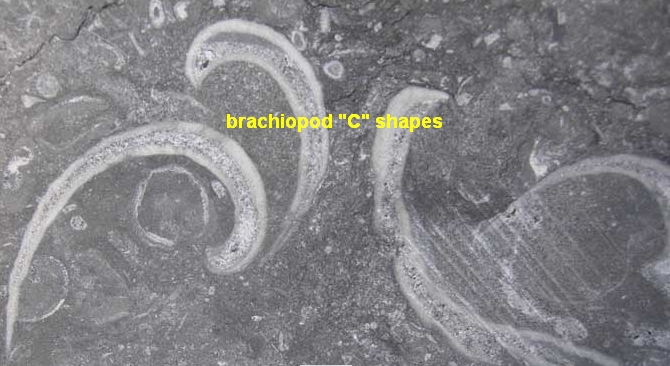
Spiral shapes

Small spiral fossils (less than a few centimeters in width)
- Most commonly gastropod (snail) fossils.
- Some coiled shapes may also be goniatites, a type of small
ammonite. Found in sandstone along the Walsh River in north
Queensland
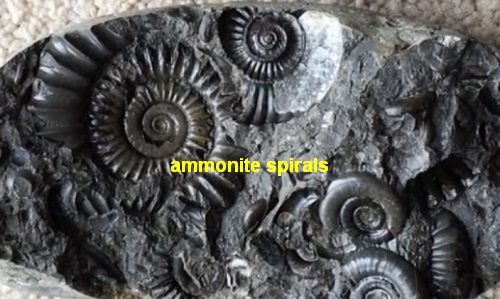
- Some graptolites are coiled. These are easily differentiated
from gastropods and goniates, in that they have saw-toothed edges
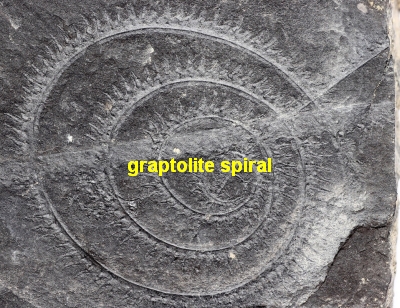 .
.
Large spiral fossils (more than six centimeters across)
- Large coiled shapes are most commonly cephalopods.
Shell shapes

Most shell shape fossils are shells Found around coal deposits in many areas, in limestones, shales and sandstones and around the edges of Australia's ancient inland sea
- brachiopod fossils may be of the outside of the shell
(called an "external cast"). External casts often have often
have have ridges or grooves that radiate from the hinge between the
valves toward the front of (across) the shell.
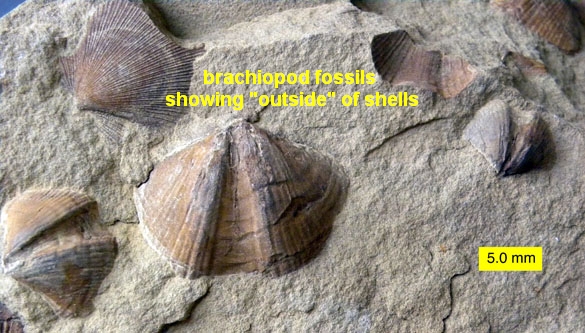
or
They may be the inside of the shell (called an "internal cast"). They ae generally smooth with a gap between then and the surrounding rock where the shell (now gone) used to be. They are made when a dead shell fills up with sediment, the shell rots away and the shape o the inside is preserved .
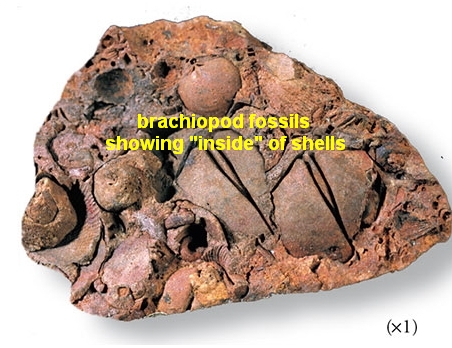
- Clams (bivalves) have have two valves (shells) that are the same (mirror images), whereas brachiopods have two shells that are different. Grooves or ridges on clams are very fine and appear as lines oriented symmetrically around the shell like a modern clam, rather than across it, as is common in many brachiopods.
Hammock shapes

- A type of coral fossil, called Favosites, has a diagnostic
hammock shape when viewed from the side. From a top view, the coral
colony is circular. Small side view look like hexagonal tubes. These
occur in Devonian limestones and modern examples are found among beach
detritis in tropical Australia

Irregular mounds (brain shapes)

- Fossil stromatoporoids
commonly occur as irregular mounds. They may also occur as mats,
and coatings on other fossils. In Devonian strata they may look like
peeling onions, or fossil manure. Some may look like brains.

- Weathered corals may appear as irregular mounds. Look for holes or honeycomb shapes to differentiate from stromatoporoids. Some may even look like brains.
- bryozoans commonly occur as irregular mounds. Most are small, only a few inches across.
- Sponges
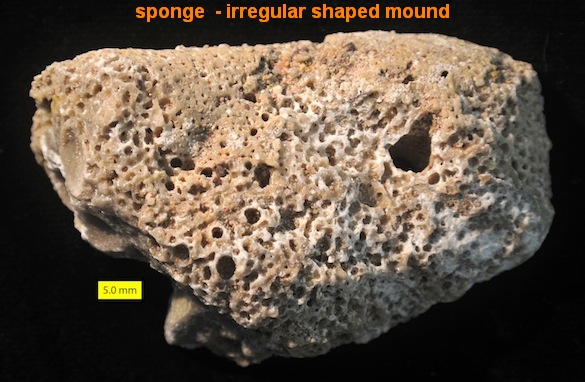
Peeling onion

- Stromatoporoids
- or if no body structure present stromatolites a type of
cyanobacteria colony that has survived since very ancient times
(living example found in Western Australia at Shark Bay, in 3.7
billion-year-old rocks in Greenland.
and 3.48 billion-year-old rocks from the Pilbara region of
north-western Australia
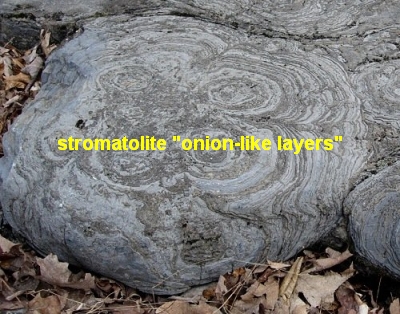

Cup shapes

- Horn corals commonly have cup shapes. If you can see inside the cup, corals will have grooves or lines radiating out from the axis.
- A type of bryozoan found in limestones has cup shape.
- The calyx of a crinoid has a cup shape. Almost always associated with bead-like crinoid columnal fossils.
- The calyx of a blastoid has a cup shape. Almost always associated with bead-like blastoid columnal fossils (indistinguishable from crinoid columnals).
- A type of trace fossil called Conostichus, often has a cup
shape. The bottom of the cup may have a small bulb or protrusion at
the base. Sometimes the bulb is 5-sided, which is why this trace
fossil is thought to be the resting trace of a sea urchin, a type of
echinoderm. These ichnofossils generally are composed of sandstone or
siltstone, often devoid of other fossils

. - some evaporative features in sandstones or siltstones such as
salt volcanoes are pseuofossils have a cone shaped appearance
(note: fossils may be present in the same rock)

Cup shapes with grooves in cup

- Horn corals commonly have cup shapes with closely spaced ridges or grooves radiating outward from the central axis. They are generally less than 3 or 4 centimeters in width, but some may be larger in Devonian strata.
Cup shapes with bulb on the bottom

- A type of trace fossil called Conostichus, often has a cup shape. The bottom of the cup may have a small bulb or protrusion at the base. Sometimes the bulb is 5-sided, which is why this trace fossil is thought to be the resting trace of a sea urchin, a type of echinoderm. These ichnofossils generally are composed of sandstone or siltstone, often devoid of other fossils.
Tooth shapes

Most of the tooth-shaped fossils found in Kentucky are not fossil teeth. Rather they are fossils of other animals.
- Horn corals are the most common type of fossil with a tooth
shape, especially in cross section. If you can see inside the cup,
corals will have grooves or lines radiating out from the axis. They
are generally less than 3 or 4 centimeters in width.
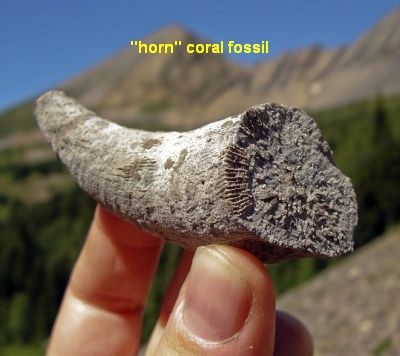
- Siderite nodules can have a tooth shape and are sometimes mistaken as fossils. These mineral nodules are not fossils. They are red to brown in color and when scratched upon a piece of ceramic will leave a reddish brown streak. Common in coal fields.
- Fossil plant roots, can sometimes have a conical shape that
could be misidentified as a tooth. Also common in calcrete deposits
along river banks in arid areas.
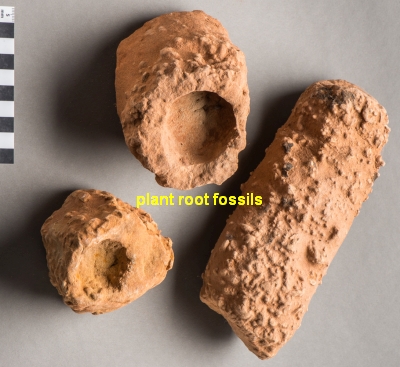
- Connularids are cone- to tooth-shaped fossils that have
transverse ribbing, that looks like fish-bones up the sides of the
cone. These fossils are uncommon to rare.
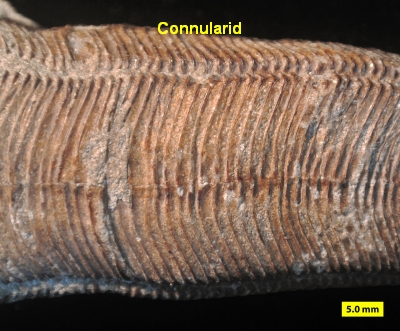
- fossil fish teeth may have a tooth or horn shape
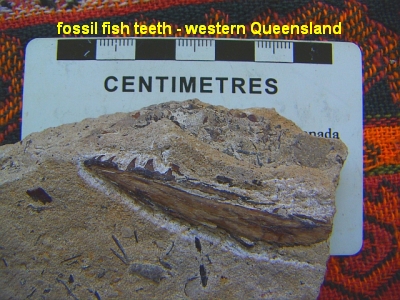
- Tusks of the megafauna Diprotodont are found in north
Queensland on the margins of the ancient sea
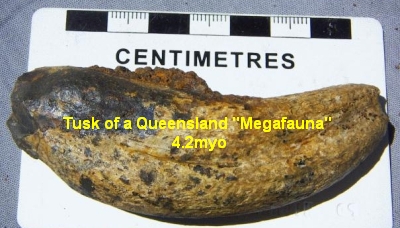
- Megafauna teeth of giant wombats, browsing and grazing
marsupials are found in north Queensland surrounding a plunge pool at
the base of a 4.2myo waterfalls - the pool was full of giant
crocodiles and giant turtles


Learn more about our megafauna expeditions
- Ichthyosaur teeth mimic horns - the jaw comes from a lagoon deposit
on the margins of an ancient 110myo sea in central Australia
Learn more about our Ichthyosaur discovery expedition
Horn shapes

- Horn corals are the most common type of fossil with a horn shape. If you can see inside the cup, corals will have grooves or lines radiating out from the axis. They are generally less than 3 or 4 centimeters in width, but some grew to lengths of more than a meter.
- Fossil Cephalopods.cuttle bones and sucker hooks can take on
a "tooth" shape
- Siderite nodules can have a tooth shape and are sometimes mistaken as fossils. These mineral nodules are not fossils. They are red to brown in color and when scratched upon a piece of ceramic will leave a reddish brown streak. They are common in Kentucky's two coal fields.
- Fossil plant roots, can sometimes have a horn shape. Large fossil tree roots may be pointed at one end.
- Connularids are cone- to horn-shaped fossils that have transverse ribbing, that looks like fish-bones up the sides of the horn. These are uncommon fossils, and are generally small, less than 5 or 6 cm.
- A large fossil fish called an arthrodire, had a hook-shaped lower jaw, that could be mistaken for a horn, especially in large arthrodires (some of these fish were as large as great white sharks). These are rare fossils, but have been found in Devonian strata. The hooks are generally more than 10 cm in length, and black to gray in color.
Horn or tooth shape with segments

- Horn corals are the most common type of fossil with a horn shape and segmented ridges. If you can see the top of the fossil, a coral will have a cup-like depression. The cup will have grooves or lines radiating out from the axis.
- Some fossil horns have turned out to be cephalopods.
Horn or tooth shape with transverse ribbing

- Connularids are cone- to horn-shaped fossils that have transverse ribbing, which looks like fish-bones up the sides of the fossil. These are uncommon fossils.
Tube shapes

Small tubes (less than a few centimeters in width)
- Broken bryozoans can have tubular shapes. Most will be a centimeter or less in diameter and only a few centimeters in length.
- Some branching corals when broken have tubular shapes.
Tubular branches of corals are common in Devonian strata. Look for
pin-holes along the tube.
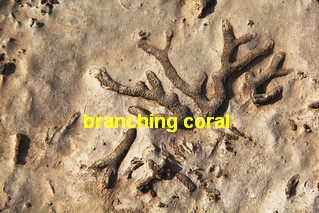
- Crinoid columns are tubular. They are generally segmented. Most are less than a centimeter in width, and are commonly associated with broken columnal debris, which are circular or bead shaped.
- Siderite nodules can have a tubular shapes and are sometimes mistaken as fossils. These mineral nodules are not always fossils. Sometimes the siderite filled ancient burrows of animals, in which case the tubes represent what are called trace fossils, or ichnofossils. Siderite is red to brown in color and when scratched upon a piece of ceramic will leave a reddish brown streak.
Large tubes
- Large tubes, more than a centimeter in width or ten centimeters in length may be cephalopods. Cephalopods commonly have segmented shells. Cephalopod shells may be conical, narrowing at one end.
- Reed-like Calamites It often exhibits grooves parallel
to the long axis of the tube, and may be segmented like bamboo. Most
fossils are four or more centimeters in diameter, and generally tens
of centimeters in length
. - Fossil tree roots.

- calcrete tree root casts - in arid areas, mineral rich water
seeps out of the water table and into the creek. The water often
follows the hollows left by rotted out tree roots and as the mineral
rich water evaporates the root hollows fill with calcium rich
calcrete deposit - it is debatable whether this constitutes a
fossil or an evaporative feature.
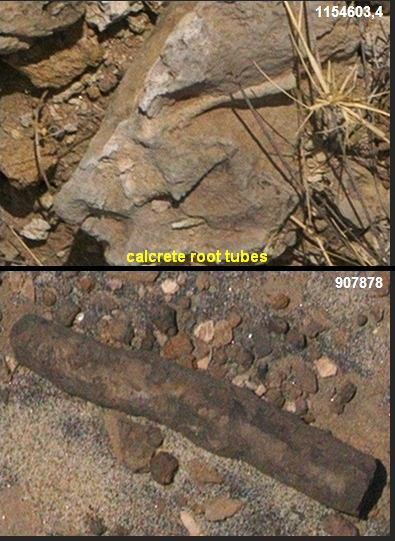
Multiple, attached tubes

- Tubes that are attached together are generally coral fossils.
The corals Halysites and Syringopora consist of very narrow tubes (mm
thick), attached together in organ-like shapes when viewed from the
side. From the top, the tubes are arranged like chain in Halysites.
These are common in Silurian strata.
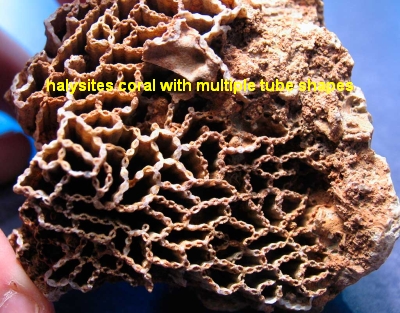
Tube with holes

- Tubes with holes are generally bryozoan or coral fossils. Bryozoans with this shape are most common in Ordovician strata, while corals with this shape are more common in Silurian and Devonian strata. -large holes (more than a mm) are mostly corals. -tiny holes can be either bryozoans or corals. -star-shaped holes are bryozoans
- Stromatoporoids can also be tubular with small holes. These are ancestors of calcareous sponges.
Segmented tube

- Crinoid columns are tubular and very common in limestones and shales. Most are less than a centimeter in width, but they can range in length to tens of centimeters. Segmented columns, are commonly associated with broken columnal debris, which are circular or bead shaped.
- Long, segmented tubes may be the shells of cephalopods. Most are 2 to 5 centimeters in width, and tens of centimeters in length. Cephalopod shells may be conical, narrowing at one end.
- The reed-like Calamites is associated with coal fields. It often exhibits grooves parallel to the long axis of the tube, and may be segmented like bamboo. Most fossils are four or more centimeters in diameter, and generally tens of centimeters in length.
- Some arthropods such as millipedes can also appear as
segmented tubes, but these are very rare.

Segmented tube with a rounded end

- Segmented tubes with rounded ends are generally fragments of cephalopod shells. Most are 1 to 3 centimeters in width, and only a few centimeters in length.
- Fossil plant roots, may have rounded ends. Usually they are a cast of a root mold and will be composed of sandstone or siltstone. Sometimes the sandstone is mineralized so that is reddish, brown, or yellow in color.
Segmented tube that comes to a point

- Long, segmented tubes that come to a point or are conical in shape are most likely the shells of cephalopods.
Branching Tubes

- In limestone, branching fossils may be bryozoans.Some
bryozoans have star-shapes on the branches
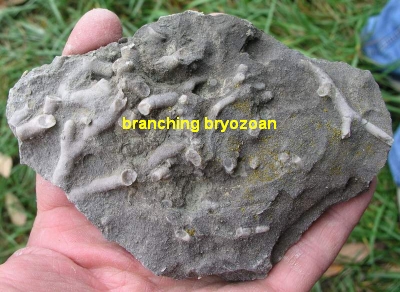
- Some corals also can have branching shapes. Branching corals are common in Devonian strata.
- Fossil plant branches occur in Kentucky's two coal fields and generally occur as black branches in gray shale or siltstone. They commonly are associated with other plant debris, like fern leaf fossils.
- The stromatoporoid Amphipora is a tiny branching tube that is common in some Devonian limestones.
Screw shapes

- Most screw-shaped fossils are Archimedes, a type of bryozoan. These
often occur in association with mesh-shaped fossils, which represent
the fronds that grew off the screw-shaped axial column of this
bryozoan.

- Some screw-shaped fossils are the remains of the axial regions of cephalopods
- Some screw-shaped fossils are the remains of the axial regions of gastropods
(snails). These will usually be coiled screws, but when
fragmented may look like a single straight screw.

Saw-tooth shapes

- The only common fossils with saw-toothed edges are graptolites.
These are generally narrow (mm's across) and dark gray to black. They
can form mesh-like patterns, and occur in Ordovician strata.
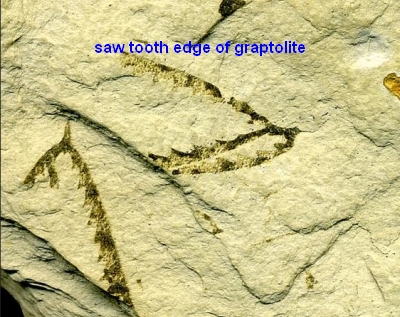
Flower shapes

- The most commonly mis-identified fossils with flower shapes are
circles of leaves, that resemble flower petals.
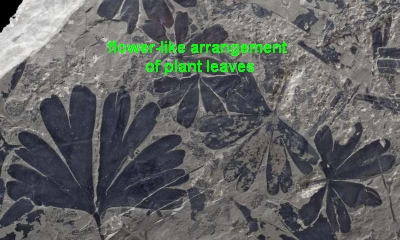
- Flower-like shapes related to echinoderms. The top view of a
blastoid calyx, often has a flower-shape on it. It can look like a
starfish on a blastoid.
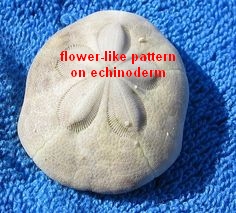
- some crab burrows can resemble flowers
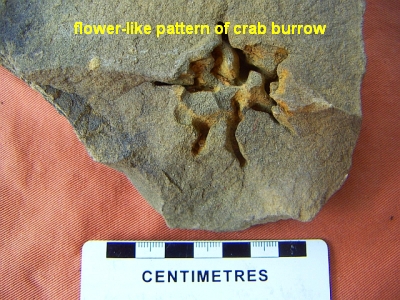
- star fish fossil can resemble flowers
- fossils of conifer tree needles can resemble flowers as can cordaite plants fossils
Needle shapes

- Some needle-shaped fossils are plant fossils, similar to
pine needles.

- Another type of plant fossil with needle shaped leaves were the sphenopsids. Annularia is the needle- or flower-shaped fossil. They are often black (from organic carbon like coal) and occur in dark gray shales of Kentucky's two coal fields.
- In limestones, needle-like fossils may represent the spines of sea urchins, a type of echinoderm. These are not commonly recognized but occur in Mississippian strata.
- In Ordovician shales and limestones, some bundles of needle-like fossils may be graptolites.
Honeycomb

- Several types of fossil corals have a honeycomb appearance. Honeycomb
corals are found in Silurian and Devonian limestones.
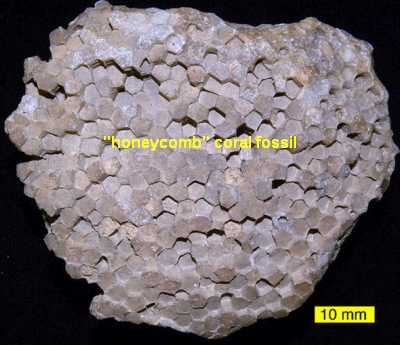
Mound with holes (bee hive shapes)

- Several types of fossil corals occur as mounds with holes in them. The holes are generally tiny (less than a mm each). Mounds range in size from a few centimeters to meters in width. These types of corals are found in Silurian, Devonian, and Mississippian limestones.
Chain shapes

- Chain shapes are common on the top surface of a type of fossil coral called Halysites, which is found in Silurian strata. Tubes or straight lines should extend downward beneath the chains.
- String of Pearls. Some chains of beadshapes are a type of trace
fossil called scalari tuba. They will generally be round beads
and the same color and texture as the surrounding rock.
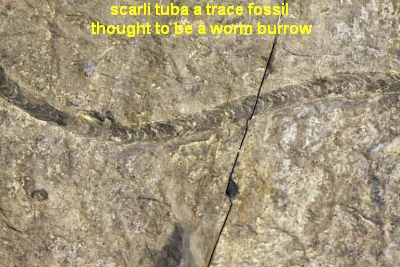
Sinuous shapes

- Most sinuous shapes are trace fossils, also called ichnofossils.
Trails of worms, snails, and other invertebrates can be preserved as
fossils and leave a sinuous shape. Often the shape is the same color
and texture as the surrounding rock.

Learn more about tracefossils
Bone shapes

Many rocks and fossils may have bone-like shapes.
- siderite
- cephalopod--long tubes
- large horn corals
- true fossil bones
marker above shows circular pit from crocodile bite
Learn more about our megafauna expeditions
Bug-like shapes

- Fossil insects are rare and trapped in amber

- trilobites are common to uncommon in Ordovician, Silurian,
and Devonian strata. Whole trilobites have three lobes or portions to
their bodies.
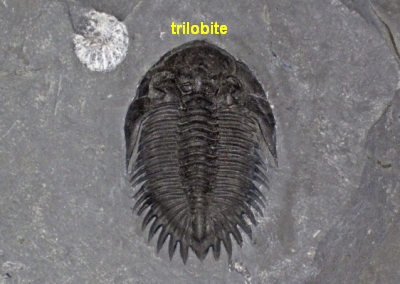
Because trilobites change shape over geological time they can be used as Index Fossils
- rare fossil arthropods
Tear shapes

- Several brachiopods, including Lingula, have tear-drop
shapes.
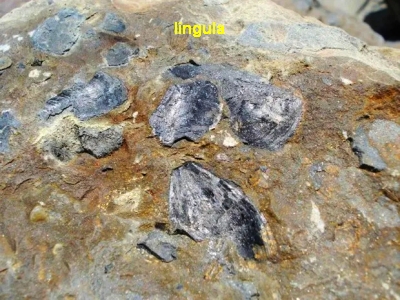
- A type of bryozoan called a chocolate-drop bryozoan, would have a tear-drop shape in cross section. These only occur in Ordovician strata.
Tear-drop shape with segments

- Several brachiopods, including Lingula, have tear-drop shapes. They may have thin ridges or segments, which represent growth lines on the shells.
Net, fan, web, or mesh shapes

- Mesh-shaped fossils are most commonly a type of bryozoan called
fenestrate bryozoans.
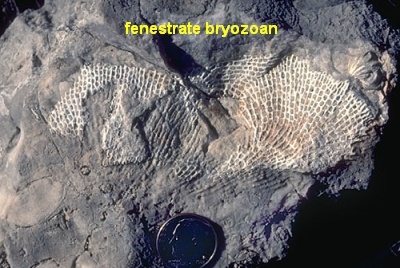
- In Ordovician strata, graptolites can form mesh-like patterns. These will often be associated with segments that have a saw-tooth pattern.
Scaly shapes, snake skin

- A common mis-identification of fossils occurs with scaly shapes are
actually the imprints of fossil lycopod tree bark. Some may
look like pineapple skin, others like reptile skin.
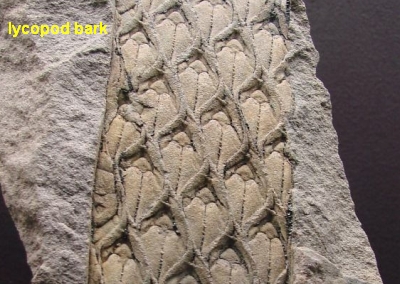
Chevron trails and Rope or loop shapes


these shapes are usually traces of invertebrates on the bottom or in the sediment of an ancient water-body.
- Chevron-ridged or indented markings are usually trace fossils,
also called ichnofossils.
Trails of worms, snails, and other invertebrates can be preserved as fossils and leave many different kinds of shapes.
Often the shape is the same color and texture as the surrounding rock. - Rhizocorallium trace fossil
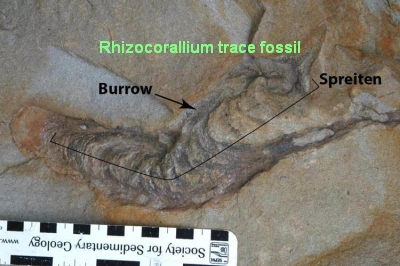
- Zoophycos trace fossil

Microfossils

Some useful fossils are so small study requires a microscope
They exhibit bewildering variety and can be used as indicators of past sea temperatures, past oxygen levels and many other purposes.
See more about microfossils

